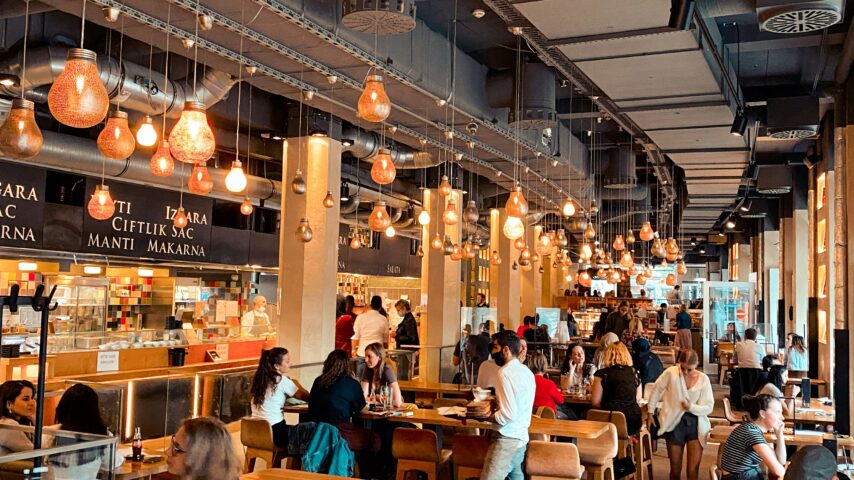Restaurants are experiencing labour shortages like never before, with the UK hospitality workforce seeing a 12% reduction since the pandemic; a figure which unfortunately seems to be growing. Effective talent management in hospitality is vital for improving performance.
High employee turnover is a significant strain on any business, particularly in the restaurant sector where margins are being pushed to their very limits. We are seeing a domino effect where staff who remain, are overstretched and causing widespread burnouts.
By some estimates, it can cost an employer double an employee’s salary to replace them when they quit. The excruciating hiring process seems to be endless, and when you have finally found your ideal candidate, the training process begins with the new hires needing the first few months to learn the ins and outs. Needless to say, the time and resources spent on replacing experienced employees could be put to better use.
1. It all starts during the hiring process
Employee turnover in the hospitality industry falls within the 75%- 85% range. But, the Four Seasons is a clear outliner, with a turnover rate of 10%. So what does the Four Seasons do differently?
Well to start, the Four Seasons recruitment process involves at least three in-person interviews with the General Manager, setting the tone for their future relationship. The Four Seasons’ hiring approach allows candidates to feel more connected to the company and their future manager. A thorough training programme lets candidates perfect their craft to perform their duties at a high level, and feel confident and supported along the way. Once working, team members are able to move around the organisation for the flexibility and opportunity to have new challenges, career promotions and travel.
A career in the hospitality industry can often be labelled as stagnant, with few opportunities to advance your career. Offering a clear outline of the career ladder available for staff members will motivate teams to remain within the organisation to obtain promotions, and new opportunities, and in turn, avoid burnout and dissatisfaction. It will in addition send a clear message to staff that you want to invest in their development.
Naturally, businesses want to attract the top candidates in the job market, with employer branding becoming increasingly popular and important since the mid-1990s. Employer branding is the process of curating your reputation as an employer of choice among job seekers. Common initiatives range from having a diverse workforce, career development opportunities and using social media platforms to highlight your work culture. Businesses need to sell their company to potential candidates before the interview stage, as well as during and beyond if they are hired and continue promoting the benefits of working at your company.
Take the case of NONA, a restaurant chain in Belgium, whose socially responsible ‘DO GOOD’ mission statement is an ideal that their employees can buy into and want to work towards. When restaurant industry teams were asked about what they looked for in an employer, 38% said the social commitment of a company is a leading factor. Employees want more from their workplace beyond being a source of income, but one where they can also feel fulfilled.
Just take a look at Pizza Pilgrims’ socials. The team always takes centre stage with colleagues having fun at after-work activities (including their bi-annual retreat to Naples). Pizza Pilgrims uses their social platforms to highlight how their staff is committed to the company’s goals, similar to NONA’s socially responsible mission statement.
Co-founder Thom Elliot also publically shouts out the achievements of his team on a regular basis. A common complaint among hospitality workers is that they feel senior management views them as replaceable, so acknowledging the good work of the team goes a long way in making them feel valued and supported. There is nothing worse than putting in the hours or providing some valuable insights which go unnoticed.
It’s great to show and promote all the initiatives you are leading to improve your work culture, but the perception you are creating must meet reality. We got to speak to Charlie Warren, head of operations at Pizza Pilgrims whose approach to staff retention is to ‘give a clear outline and support to your staff on how they can achieve their next goal.’
Hospitality is an industry where the individual is tested on a range of skill sets, from interpersonal skills to problem-solving, that allows staff to gain comprehensive for personal development and other career opportunities. It is precisely the role of hospitality leaders to rave about the development that individuals can achieve, and shift the focus away from portraying hospitality as ‘unskilled labour.’

2. How to get feedback from your staff
You might be experiencing high employee turnover, but why?
Understanding why people are leaving or are unhappy is critical to tackling the issue. For instance, is it because there needs to be a better maternity/paternity package or an improved onboarding process? It can be nerve-racking for employees to openly voice issues to their employer, it’s all about creating a safe environment where staff can easily vocalise feedback without fear of repercussions.
Regular check-ins are key, as the hospitality industry is so fast-paced, pulse surveys that ask team members a few questions to anonymously give their thoughts on a weekly basis could be a more viable solution than an in-person meeting.
Pulse survey’s can be used to ask a range of issues, from opinions on operation procedures, company aims and leadership evaluation to name a few. You want to engage your employees every step of the way, in turn, there will offer responses that may help offer a different perspective and provide valuable feedback.
The first step is to monitor the morale of your employees regularly, the next is to put this data into action. Schedule time in to review the results and brainstorm initiatives to address the issues at hand. For instance, if a common trend in responses is a lack of teamwork, splitting tasks between various individuals could encourage comradery, alongside organising team days to stimulate co-worker relationships.
Beyond responding to regular check-ins, there should be established procedures for employees to submit their feedback. You want to transmit the message to your employees that their opinions are being taken on board by senior management. Even when team members, unfortunately, do decide to leave, arrange an exit interview as an opportunity to understand the reasoning behind your employees leaving and more broadly to review their time and experiences at your company.
3. Streamline operations to supercharge performance
In a survey, 58% of hospitality workers said a shortage of colleagues was their biggest concern, given the extra workload that will bring. As the industry’s workforce is shrinking at an alarming rate, streamlining operations to ensure labour is as effective as possible is a no-brainer. Self-service technology, for instance, kiosks, eases the labour burden experienced by restaurants where staff can now redirect their efforts from manual tasks can now be automated to have more time to serve customers and ensure an enjoyable experience.
In a recent survey performed by Vita Mojo, 64% of those surveyed said they would order more when using kiosks, which rises to 92% for Gen Z, due to the increased freedom and quick ordering time. Buying a kiosk can range from $2,000 to $5,000, which is a considerable investment, if this falls outside your budget, renting a kiosk in the ballpark of $500 could be a more appropriate alternative, particularly if you want to first test out the effectiveness of self-service for your restaurant. Also, remember if kiosks’ are implemented correctly are an investment, not only do customers on average spend 30% more, but also allow the team to prioritise other tasks.
The technology initiatives do not stop there, with staff at an average site with ten fridges and freezers spending an estimated 1.5 hours conducting and recording three temperature checks per day. The task can be significantly streamlined by using wireless IoT sensors that constantly monitor temperature 24/7 and automatically stream data to a central dashboard.
According to research by NSF International, 27% of quick-service restaurant teams simply switch off kitchen equipment that is not performing correctly. They lack either the time or expertise to fix the problem. Wireless sensors monitor storage temperatures and can provide an indication of equipment health. This form of predictive maintenance means failing equipment can be identified early for repair or replacement.

Conclusion
Staff management can be a daunting task for any restauranteur that can seem to be an endless challenge. Starting with one initiative and building on those results and gradually testing out more projects can make this obstacle more manageable. We have mentioned an array of potential measures to improve staff engagement, namely investing in the development of your staff from the onboarding process to offering a clear career progression path. The on-going monitoring of staff morale to implement practical solutions to address concerns and suggestions. Streamlining operations through the use of technology to automate tasks can ease the burden currently placed on staff. The current obstacle faced by hospitality leaders can not be underestimated and will take transformative action but this is an industry known for its resilience and innovation.





